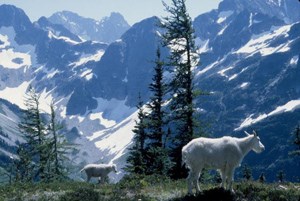|
The earth laughs in flowers.
-Ralph Waldo Emerson

NPS/Pat Milliren Many believe the Easy Pass and Fisher Basin area to be one of the most superb places in the North Cascades. Extensive meadows are crowned by glacial peaks. The short, steep trail to the pass is anything but "easy." The views, however, are your reward: panoramic vistas of Fisher Basin and Mounts Logan, Fisher, and Arriva. In the spring and early summer, wildflowers abound, and in the autumn, golden larches make this area even more special. Backpackers will enjoy camping in Fisher Basin and along the wild and shady Fisher Creek. See the detailed trail description for more information on this area. Special Concerns:
Backcountry Camping: A backcountry permit is required for all overnight stays. Permits are limited. There is no camping allowed at Easy Pass or in the meadows. Fisher Camp is located in the basin below the pass. Midway along the Fisher Creek Trail, find Cosho Camp in the forest, and Junction Camp is located at the intersection with the Thunder Creek Trail. Access: Follow State Route 20 to mile 151. The trailhead is located on the south side of the highway. A US Forest Service Northwest Forest Pass is required to park here. 
NPS/Autumn Carlsen Detailed Trail Description Three hundred yards (270 m) from the trailhead, cross Granite Creek on a footlog and head up into the forest. After two miles (3 km) of western hemlock and Pacific silver fir forests, the trail emerges into avalanche paths on the flanks of Ragged Ridge. Look for spring-time glacier lilies emerging from the snow. The pass can be seen high above. The trail now climbs steeply, crossing Easy Pass Creek three times, traversing steep rock slopes and avalanche meadows. Look and listen for pika and hoary marmots. The trail can be lost in lingering snow fields. An ice axe is advised through early summer. Easy Pass is spectacular, separating Granite Creek Valley and the drier mountains to the east from the glacier-mantled peaks ringing the Fisher Creek drainage to the west. Scattered clumps of trees include subalpine larch, subalpine fir, mountain hemlock, and farther up the ridge, whitebark pine. The larch, a deciduous conifer which turns gold before losing its needles in the fall, is found only in the northern fringes of the United States and the eastern ridges of the North Cascades. The trail into Fisher Basin is steep and scenic. Massive Mt. Logan looms ahead. Lush meadows bloom in pinks, reds, purples, whites, and yellows. Deer and smaller mammals abound. Black bear are often seen grazing in the meadows, eating huckleberries. Just prior to protection under the National Park Act in 1968, one of the last grizzly bears in the North Cascades was shot here. The Fisher name comes from the Fisher brothers who ran a trap line here in the early 1900s. Fisher Camp is at the edge of the meadows, two miles (3 km) beyond the pass. Leaving the meadows, the trail descends gently, entering the mature silver fir forest of the Fisher Creek Valley. Creekside Cosho Camp is in the deep forest, 6 miles (9.6 km) beyond the pass. This is an entirely different life zone, home to martin, owls and their prey, including flying squirrels, voles, and deer mice. Continuing down valley, the forest gradually changes to mid-elevation species of western redcedar, western hemlock and cottonwood in stream flats. A mile from Junction Camp, an old trapper's cabin is semi-hidden just off the trail. Rock Cabin was built against a great rock, using the rock as one wall. This unique cabin has been stabilized by the National Park Service, and today serves as a reminder of the human history in this remote valley. Junction Camp is situated near Fisher Creek on the ridge overlooking Thunder Creek Valley. Views are good from this area, including a glimpse of Boston Glacier in the distance. From Junction, you have several options: retrace your steps to the Easy Pass trailhead; hike down the Thunder Creek Trail 10 miles (16 km) to Colonial Creek and State Route 20; or head 17 miles (27 km) up and over Park Creek Pass and into the Stehekin Valley.

NPS/Rob Burrows 
|
Last updated: September 1, 2021
